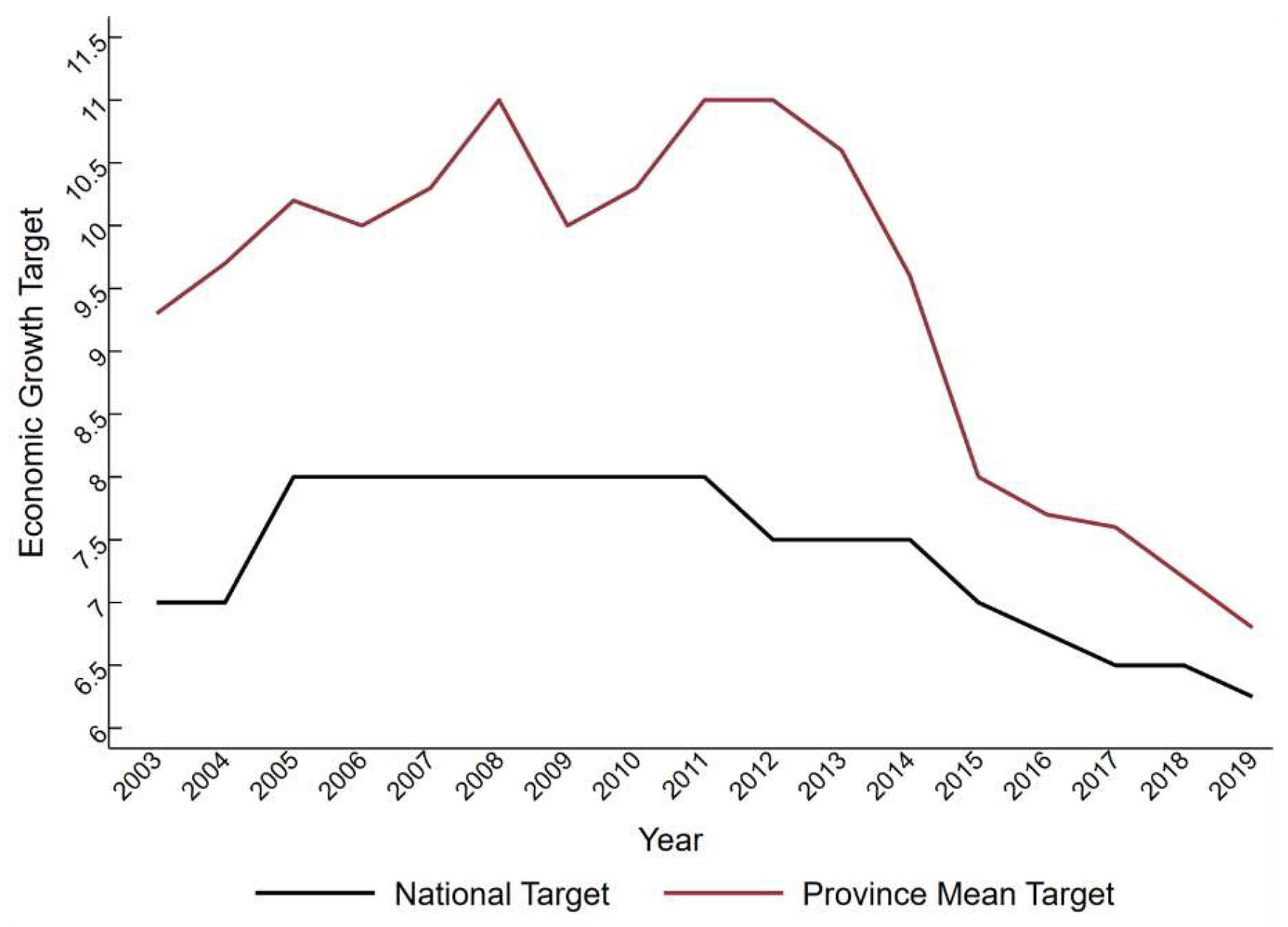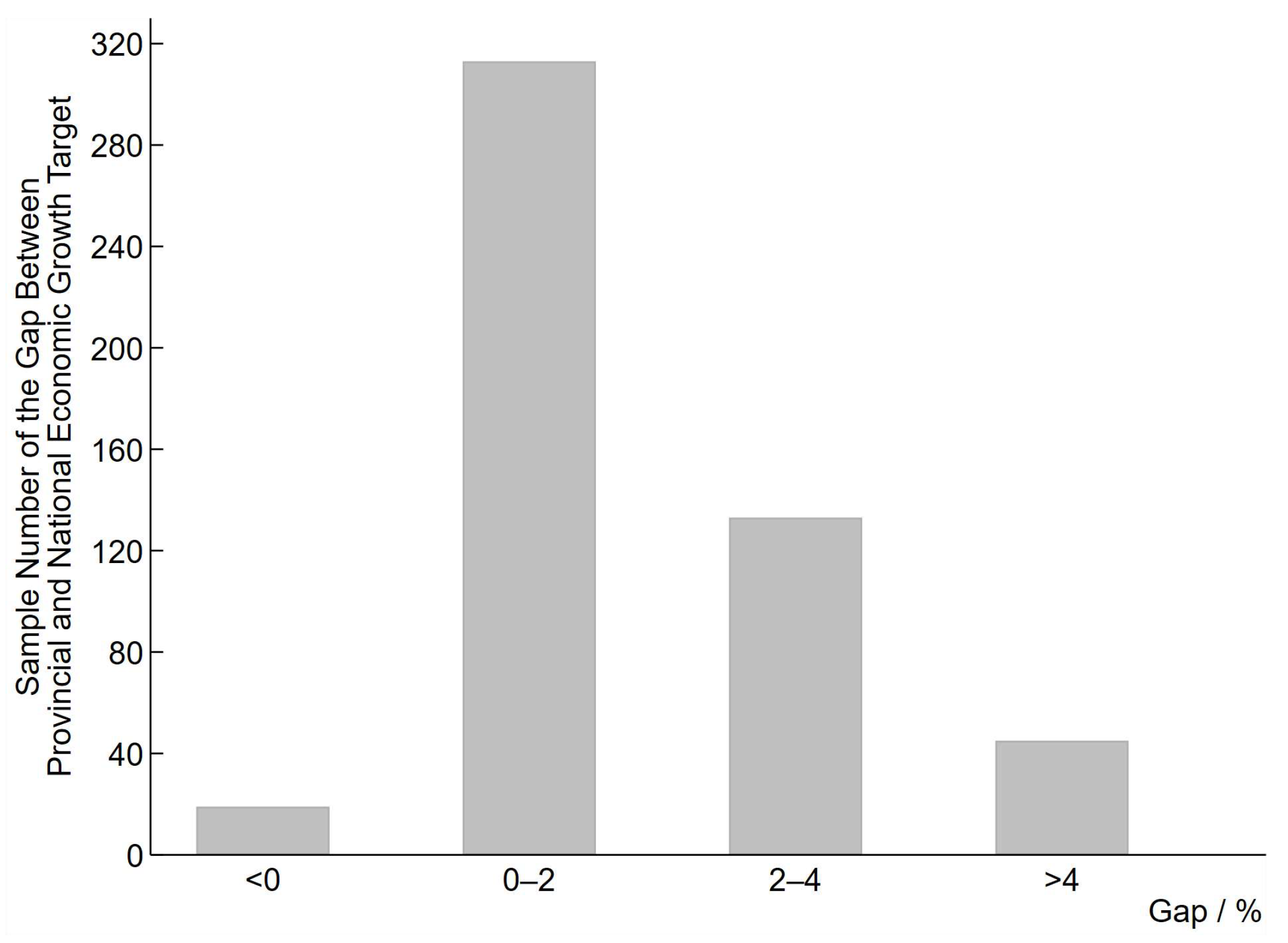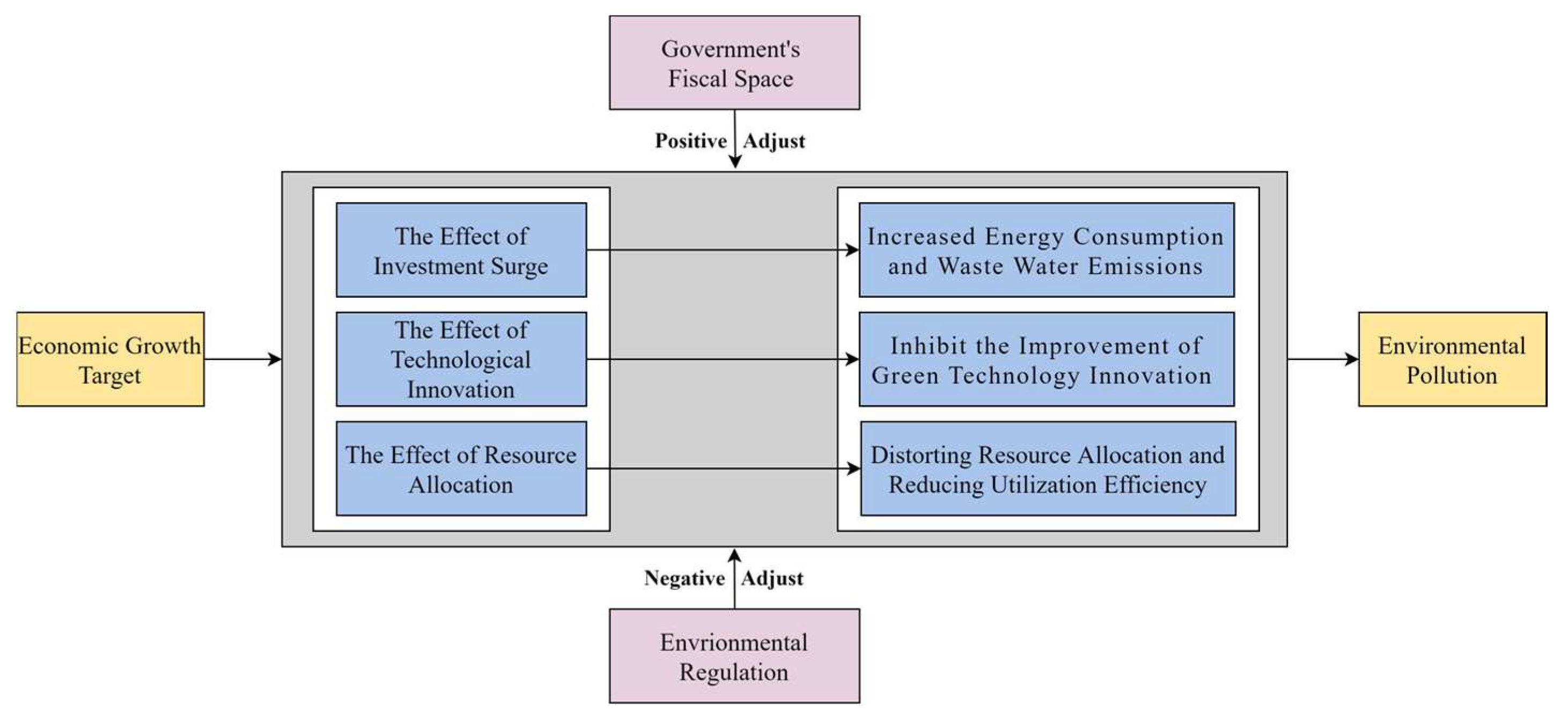1. Introduction
The growing EP situation has caused many negative impacts on food security, social economy development, and land health condition, being a global challenge that threatens human survival and sustainable development in all countries [
1,
2]. The global characteristics of the EP problem have attracted worldwide attention, more than 150 countries and regions have announced a carbon neutrality target and carbon peaking target. The Chinese government is no exception. General Secretary Xi Jinping presented an ambitious aim “striving for carbon peaking by 2030 and carbon neutrality by 2060” at the 75th UNGA (United Nations General Assembly) in September 2020. The aim not only reflects China’s determination to promote global environmental governance and maintain sustainable development, but also demonstrates the determination to construct a community of common destiny with all countries in the world. However, China’s long-standing extensive economic growth model has caused a serious EP problem and the ecological environment has been increasingly deteriorating. The 2022 Global Environmental Performance Index reported that the EPI score of China is 28.4, ranked 160th out of 180 countries, far below Denmark (77.9), the UK (77.7), and Finland (76.5). The 2022 BP World Energy Statistics Yearbook reflects the carbon emissions of global regions, among which, China’s total carbon emissions are 10,523 megatons and the carbon emissions growth rate is as high as 5.8%, ranking at the top in both total carbon emissions and growth rate. The development trend will continue, which is detrimental to the green development of the world. China’s EP problems not only impede national economy development but also cause irreparable damage to citizens’ physical and psychological health, severely limiting the achievement of sustainable development and the aim of high-level economic development [
3,
4,
5].
The deterioration of the EP situation forces all countries to accelerate discussions and research on topics such as sustainable development and circular economy (CE) development, and the development of CE is gradually becoming the common view in many countries [
6]. From 2014–2016, the number of circular economy articles published increased from 30 per year to 100 per year [
7]. The Regulation on Waste issued by the European Community in 2008 stressed that waste management is an important aspect of CE, and 4R (reduce, reuse, recycle, recover) are identified as the key of CE policy implementation [
8,
9]. Additionally, many great consulting firms such as Deloitte, Ernst & Young, and McKinsey also published CE reports and white papers [
10,
11,
12].
From the perspective of world trade, UNCTAD (United Nations Conference on Trade and Development) presented that in today’s highly economic globalization, the management of the global resource cycle entails the cooperation of all countries to maintain the circularity of products in international trade. As the world’s second-largest economy, China has engaged in the upstream and downstream of global value chains and caused a significant impact on the global resource cycle. Moreover, the Chinese increasingly promoted high-quality economic development and also focused on the future of CE. As a result, the highest managers continue to elevate CE’s strategic status, eventually recognizing it as a national strategic policy. China’s CE policy began during the Hu-Wen administration. In 2005, the state council of China issued Several Opinions on the Development of Circular Economy, which clarified the guiding ideology, fundamental principles, and primary goals of CE. The Circular Economy Promotion Law of the People’s Republic of China issued in 2008 was a milestone in the development of China’s CE at the legal level. In 2015, the CPC Central Committee and the State Council issued Opinions on Accelerating the Construction of Ecological Civilization, stressing that green development, circular development, and low-carbon development are the main ways to construct China’s ecological civilization, denoting that the CE of China has stretched into all aspects of society. In the meantime, the development conditions of Chinese society and the national development strategy provided “ground” for the implementation of CE. The Eleventh Five-Year Plan (2006–2010) and Twelfth Five-Year Plan (2011–2015) take building a resource-saving and environment-friendly society as one of the important tasks of development. The 14th Five-Year Plan (2021–2025) entails constructing a modern economic system, promoting high-quality economic development, and promoting green development. Although the strategic thinking behind the development of CE has been fully carried out, it is hard to measure the development level of CE in different regions. Referring to Pesce et al., this paper creates a conceptual model of CE development and judges the distribution and development level of CE in different regions of China based on six indicators: system thinking, innovation, stewardship, collaboration, value optimization, and transparency [
13].
Since 1950, China has consistently announced EGT and used EGT to macro-manage national economy development. From the view of the EGT setting method, Chinese governments formulated EGT of China’s Five-Year Plan through NPC (The National People’s Congress). The Chinese government also declares the year’s national EGT in its Government Work Report and gives guidance to each provincial government on economic development, decomposing the national EGT to local governments in different levels through the administrative hierarchy system. However, a majority of local governments set a high EGT compared with higher-level governments. It can be explained that China’s vertical governance model makes “layer by layer phenomenon” and “top-down competition for scales” commonplace [
14,
15]. It has an irrepressible amplification effect on EGT, namely, that EGT set by local governments are higher than those set by central government. Hence, under China’s top-down management system and vertical governance model, to obtain the qualifications for promotion, government officials must pay more attention to the achievement of EGT, thus, the target can be easily executed in China.
Figure 1 illustrates the provincial average EGT as generally higher than the national EGT from 2003 to 2019, demonstrating that EGT is amplified through “layer by layer phenomenon.”
Figure 2 further reports the gap in provincial EGT and national EGT from 2003 to 2019, which shows that the majority of the provincial EGT are higher than national targets, and the gap is mainly concentrated in the range of “0–2%” and “2–4%”, further reflecting the phenomenon of “layer by layer.”
The constraints of EGT will further influence local government behavior. For one thing, EGT setting level directly represents the local government’s confidence in economic construction of jurisdiction. EGT achieved or not will largely affect the promotion and political future of government officials [
16], which can strengthen the work enthusiasm of government officials, improve their work efficiency, and motivate officials to fulfill EGT perfectly. For another aspect, EGT has an important constraining effect on local government behavior. To achieve EGT, local governments probably adopt some extreme measures to obtain rapid economic growth. For instance, implementing “racing to bottom” strategies in environmental regulation even sacrifice the environment to achieve EGT [
17]. As a result, under EGT constraints, local governments may allocate resources to projects that are conducive to boosting economic growth, and the behavior may further influence EP, which is the primary concern of this paper.
Specifically, we propose the theoretical hypotheses from existing relevant economic theories, and empirically test the research hypotheses by manually collecting EGT data announced in the Government Work Report from 2003–2019 for 30 provinces in China. The baseline estimation results indicate EGT significantly aggravates EP, and the finding is robust. These basic conclusions are not substantially changed after IV estimation and many robustness tests, such as changing measurement methods of main variables, eliminating the non-linear relationship, eliminating the sample of municipalities, adding additional covariates, and eliminating the effect of outliers. The mediating effect results denote that EGT significantly increases local investment level, inhibits innovation development, lower resource allocation efficiency, and thus exacerbates EP. The moderating effect results show that the higher government’s fiscal space level will make the effect of EGT on EP greater. The stronger environmental regulation intensity will make the effect of EGT on EP smaller. In the end, the heterogeneity tests show the impact of EGT on EP is more significant in provinces that employ “hard constraint” in EGT formulation and achieve EGT.
Compared to existing research, the main contributions of the paper are as follows: First, in terms of the research topic. Even if several scholars have studied the effect of EGT [
18,
19], few studies specifically examine the link between EGT and EP. The research conducted by Chai et al. and Wang et al. is closest to this paper but mainly focuses on air pollution problems and carbon emission situations, respectively [
20,
21]. In this paper, we comprehensively build an environmental pollution index (EPI) from three dimensions of pollution structure to reflect the EP conditions in each province. Moreover, we further investigate the channels of EGT aggravating EP and consider the moderating effect of EGT on EP. It is an effective addition to existing research. Second, in terms of theoretical contribution, the traditional goal-setting theory mainly focuses on the incentive effect of goals on micro-individuals [
22,
23], but this paper identifies the impact of goal-setting from the macro aspect—EGT set of government, which expands the theoretical boundary of goal-setting theory to a certain extent. Third, in terms of practical significance, the macro-control of national economic growth through the setting of EGT is not unique to China, and it has been a global phenomenon. From the 1950s, the number of economies which announced EGT gradually increased and peaked in the 1970s. The number of economies which have announced EGT showing a renewed upward trend in the beginning of the 21st century. According to statistics, up till now, at least 110 economies around the world have announced or are still announcing growth targets, such as European countries, India, China, Vietnam, and Japan [
24]. Hence, the conclusions of the paper can provide a reference for government departments of each country to effectively balance economic growth and EP, and to scientifically set EGT.
The rest of this paper is as follows.
Section 2 is a literature review.
Section 3 presents a theoretical analysis and research hypotheses.
Section 4 describes the model, variables, and data.
Section 5 shows the empirical results and analysis.
Section 6 is a complementary analysis, including the test of mediating effect, moderating effect analysis, and heterogeneity analysis.
Section 7 summarizes research conclusions and presents relevant policy recommendations.
7. Conclusions and Policy Implications
The Chinese government has consistently used EGT to manage economic growth in the process of economic development for a long time. EGT acts as an essential position in increasing governance enthusiasm of local government officials and promoting the rapid growth of the local economy. And the influence of EGT gradually stretches from economic performance to other areas of economic development, further affecting the sustainable development and ecological environment protection of China. Under this background, this paper manually collects EGT data from provincial Government Work Reports in China from 2003–2019, and examines the impact and mechanisms of EGT on EP. The conclusions are as follows: (1) The basic regression results demonstrate that EGT can significantly aggravate EP and increase the provincial EPI level, and this finding still stands after IV estimation and robustness tests such as changing the measurement method of explained variable and core independent variable, eliminating the non-linear relationships, eliminating samples from municipalities, adding additional covariates, and eliminating the effects of outliers, demonstrating the robustness of paper findings. (2) The mediating effect results show EGT will significantly increase the regional fix asset investment scale, inhibit technology innovation, and decrease resource allocation efficiency. (3) The test of the moderating mechanism finds that government’s fiscal space and environmental regulation have an impact on the effect of EGT on EP. The government’s fiscal space is higher, the effect of EGT on EP is greater. The degree of environmental regulation is stronger, the effect of EGT on EP is smaller. (4) There is a heterogeneity in the impact of EGT on EP for provinces that adopt “hard constraint” to formulate EGT, and provinces that achieve the formulated target will significantly aggravate EP. To summarize the above conclusions, we suggest some policy recommendations as follows:
First, weaken the relationship between EGT and the promotion assessment system and rationally formulate EGT for different regions. The central government should not solely focus on high GDP growth rates when formulating EGT. Instead, it should combine the requirements of social sustainable development, and balance the link between economy development and environmental development. Furthermore, the central government should also strengthen ecological civilization construction to prevent excessive EGT from aggravating regional EP. Meanwhile, the local governments ought to rationally formulate EGT and avoid “layer by layer” based on EGT announced by the higher-level governments. Therefore, Chinese governments should lower the weight of GDP indicators in government officials’ performance assessment systems and establish a comprehensive performance assessment system that includes environmental indicators such as sustainable development and environmental protection level. In addition, the central government should also make appropriate adjustments according to the actual development and economic level of different regions, apply different assessment systems to officials in different provinces depending on local conditions, and continuously improve the government officials’ assessment system to increase the fairness and reasonableness of promotion.
Second, improve the impact of the investment surge effect, technological innovation effect, and resource allocation effect on EP. From the perspective of the investment surge effect, government departments should control the investment scale, optimize the investment structure, improve investment efficiency, formulate investment agreements that are beneficial to environmental development, and avoid the blind investment attraction behavior that aims at achieving the set EGT. From the view of technological innovation effect, government departments should rationally allocate the limited resources, promote the financial resources’ allocation efficiency, and ensure financial resources will be allocated to the fields of technological innovation, science and technology, education, and other fields that promote long-term economic growth. Moreover, government departments should also encourage the effective innovation of enterprises, formulate relevant policies to promote the innovation enthusiasm of all sectors of society, and create a positive innovation atmosphere to better achieve the sustainable development of society. From the perspective of resource allocation effect, government departments should maintain the resource allocation status of the factor market and ensure the spontaneous resource flow in the market. In addition, to improve the flow rate of resources between enterprises and the market, government departments should also increase the utilization efficiency of social resources, and accelerate the transformation and structural upgrading of relevant industries.
Third, decrease government intervention level and increase environmental regulation intensity. For one way, government departments should reduce or avoid intervening in the normal economy development to prevent the distorted allocation of fiscal expenditures, and decrease the positive adjustment of government’s fiscal space on the EGT pollution effect. Meanwhile, we should fully utilize the market’s proactive effect in the process of social resource allocation and make resources spontaneously circulate among various departments of society. For another way, government departments should increase environmental regulation intensity in economic development to push jurisdictional enterprises to accelerate the speed of green technology innovation, eliminate pollution-intensive industries, and realize the economy and society’s sustainable development.
Fourth, set the regional EGT according to different regional development conditions, instead of setting EGT with a “one-size-fits-all” method. The findings of this paper indicate that the “hard constraint” on EGT formulation drives government officials to focus on economic growth while neglecting environmental protection and development and aggravates regional EP under the influence of “layer by layer.” In contrast, the “non-hard constraint” on EGT formulation will reduce the pressure of economic growth on government, improve the total factor productivity level under the setting method of “allow leeway”, and decrease the impact of EGT on EP. At the same time, the provinces that achieve EGT have a significantly destructive impact on the environment, while provinces that do not fulfill the target have a non-significant destructive effect on the environment. Therefore, the central government cannot uniformly set the target while formulating EGT for different regions. It should carefully consider the current state of different regional developments, analyze the favorable directions for future development of different regions, integrate the local existing resources to set EGT based on local conditions, and finally realize the win-win situation of economic growth and sustainable social development.











